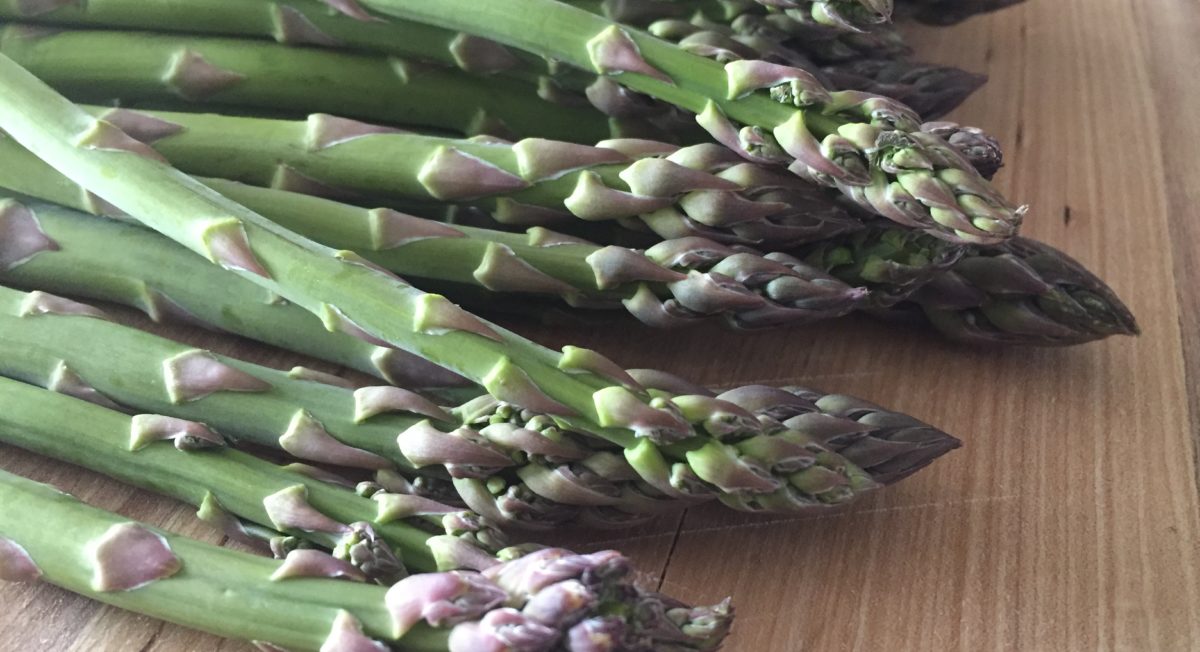As we are right in the swing of Manitoba asparagus season, I wanted to take a look at how this beautiful vegetable is grown and provide a little insight on the proper ways to cook with it. Asparagus is one of those vegetables that can frighten novice cooks as its texture and smell can be quite intimidating.
Asparagus season runs from late May to mid June (about now) in Manitoba, making it one of the first vegetables to hit the farmer’s markets in the springtime. The season is short and producing this vegetable can take a great deal of patience, but it is all worth it, because you cannot beat garden fresh asparagus.
Growing this vegetable can be a time commitment, as you will not harvest the plants for the first two years. Asparagus is a perennial, also known as a plant that returns year after year without replanting. If you tend to it appropriately in the first few years, you will reap the benefits of your hard work for up to 25 years.
Asparagus prefer sandy soil that is not overly acidic. The bed needs to be at least 12 inches deep as the roots of the asparagus need room to grow deep in the soil. The roots need the depth to avoid the heavy frost in our cold Manitoba winters. If the plants cannot grow deep enough the cold will keep the plant in its dormant state and it will not return in the spring.
When planting the asparagus, the most important thing to consider is the location. If tended to properly, this could be the plants home for the next 25 years. Select your location wisely. When sowing the plants, they are placed seven to eight inches apart and the crown, also known as the buds of the plants, must be on top of the soil line. If you plant the asparagus too deep, it will not return the next year as the plant will not be strong enough to push through the soil.
In the late spring, the asparagus will be ready to harvest. The grower must ignore the urge to cut the spears in the first two seasons, as doing so will cause the asparagus plant to become weak. The plant will not have enough energy to push the plant through the soil in the following spring, thus the plant dies.
After two spring seasons of not cutting the plant, the spears will become strong and thicker than a pencil in width. The spears will range anywhere between four and fourteen inches tall. The spears can then be cut with a sharp knife along the soil line and are ready to eat. Once the plant is cut, it will continue to grow and send up another spear. It is ill-advised to cut each plant more than twice a season as you may run the risk of the plant becoming weak and not returning the next year.
Once the harvest is over, the plant will eventually turn into an extremely tall fern-looking plant. It is important to leave these plants and not cut them until after the first heavy frost in the fall. The rule of thumb states that the larger the fern in the fall the better the harvest will be in the following spring. After the frost hits, the grower can decide to cut the plants down or leave them to catch snow and provide more moisture to the soil throughout the winter months.
These fern looking plants help the plant become stronger each year, thus more and more asparagus will grow. As the plant becomes stronger, the crown will begin to spread and send more and more shoots up through the soil as the years continue. Some plants may have as many as nine shoots off one single plant.
This plant is remarkable as it produces asparagus year after year. Its bright green colour is a great addition to any menu and its amazing crisp texture and fresh mild flavour are a true treat.
Here are a few simple tips to remember when cooking with asparagus:
- Always try to find the freshest product possible. As asparagus ages it can become stringy or woody in texture.
- Cut or snap off the tough ends. Either use a knife or your hands, take off approximately three inches from the bottom of each spear. This part is very stringy and almost inedible.
- This green vegetable can be served hot or cold and can be eaten cooked or raw. If you are trying it uncooked, remember to cut the spears into thin slices to enjoy their crisp texture.
- Grilled, sautéed, roasted in the oven or steamed are the best methods of cooking. Try to stay away from boiling or puree as this green vegetable tends to cook quite quickly and will becoming very stringy.
- Do not overcook. One of the most appealing things about asparagus can be its texture. When cooking, with any method, cook until just tender.
- The nice crisp texture of this vegetable makes it an excellent addition to salads, appetizers, or stir-fry’s.
- When seasoning, stick to simple flavours. Delicate flavours like butter, lemon zest and olive oil are the perfect match for the robust flavoured asparagus.
- Do not forget the salt and pepper. These humble seasonings provide a kick to the asparagus and enhance their true flavour.
Fun fact: Did you know that white asparagus is the same plant as green asparagus? The plants are covered to avoid direct contact with sunlight. The sunlight forms the chlorophyll in the plant, which creates the bright green colour. The lack of sunlight keeps this plant a striking white colour.
